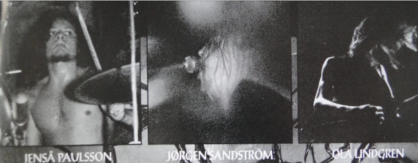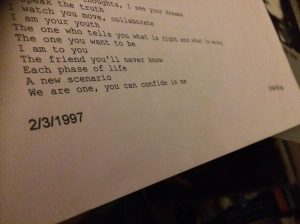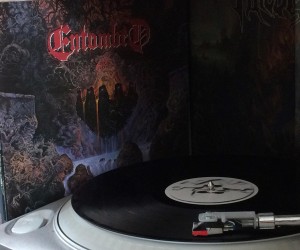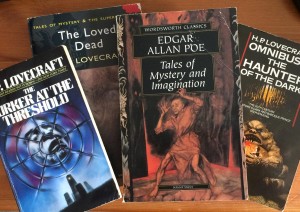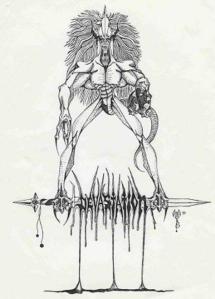Filed under: death metal, horror cinema, internet and music, Is this where I came from? | Tags: Aenigma, Carlo Maria Cordio, From Bellatrix to Betelgeuse, Lucio Fulci, Sadist, Tommy Talamanca, Tribe
It’s been a while since I’ve written something for this series of posts, but the reason is not a lack of intertextual references in music. On the contrary, I constantly come across cool new cases of musicians referencing other musicians. But, it had been a while since I came across a really interesting one, until recently, when I re-watched Lucio Fulci’s Aenigma, and I suddenly realised that part of the film score is almost identical to a melody of a song by Sadist. This is an interesting case for various reasons. First of all, it is another example of the intersection of horror cinema and metal music. Secondly, it sheds light to an interesting part of the Italian rock lineage, tracing Italian death metal back to Italian prog rock.
 Carlo Maria Cordio – Aenigma (1987)
Carlo Maria Cordio – Aenigma (1987)
Lucio Fulci is a legend of Italian gory horror. Although I prefer Joe D’Amato, Fulci’s Zombie Flesh Eaters (1979) and The city of the living dead (1981) are all-time favourites of mine. Aenigma is a really cool film about a girls’ college, where the hospitalisation of a bullied student following a prank sets off a series of mysterious deaths. I think of it as a mix between Suspiria (Dario Argento, 1977) and Carrie (Brian De Palma, 1976). Classic Italian awesomeness, including all the staples of the genre, including dreamlike suspenseful sequences, gruesome deaths, nudity, etc. Carlo Maria Cordio is a composer who’s written scores for other masters of the genre, like Joe D’Amato’s awesome Absurd (1981). The music he wrote for Fulci’s Aenigma is an appropriately cool Italian horror soundtrack with the expected prog rock vibes, Hammond organ, etc. The five note melody starting at 0:56 (C-G-G#-D#-A#, For guitar it’s basically a capo at the 8th fret) is the one I presume inspired Tommy Talamanca of Sadist.
 Sadist – From Bellatrix to Betelgeuse (1995)
Sadist – From Bellatrix to Betelgeuse (1995)
Sadist is another one of those death metal bands that blew my mind when I first got exposed to the genre. I first listened to them from a friend’s cassette tape which had Above the light (1993) on one side and Death’s Symbolic (1995) on the other. I remember listening to it on my Walkman on my way to school and my knees would buckle every time one of the guitar solos would kick in (the one near the end on “Sometimes they come back” is still one of the most amazing solos I have ever heard). “From Bellatrix to Betelgeuse” is a fantastic instrumental song off the band’s second album, Tribe, which also happens to be the last Sadist album I like. The first time I heard of Tribe, and the first time I listened to a song off it, was during the first days of the internet in my family home, sometime in early 1997, when I found Sadist’s website where they had uploaded snippets of songs (it was the eponymous “Tribe” I listened to). The melody at the beginning of the song is the one I think may have been inspired by Aenigma. It is the same chord, although Tommy (Sadist’s leader) expanded it by four notes, and overall the melody sounds very similar.
Filed under: death metal, internet and music, music video | Tags: Defleshed, Fleshless and wild, Night vision, Premiere, YouTube
The promotional method of YouTube premieres is one I didn’t participate in until recently for the first time. YouTube premieres attempt to create an experience which is unique and makes music fans feel that they participate in something special that once it’s transpired it cannot be experienced again. A specific song premiere can only happen once; it resists replication. YouTube premieres appeal to people’s desire for exclusivity and the feeling of being first to have experienced something online, in a world where seemingly everything is open to everyone with a digital device and an internet connection. Over the years, numerous times I have seen YouTube users claiming “First comment!” on comments sections. YouTube premieres tap into this desire, and, by doing so, generate interest in and raise awareness of new output by artists.
 The first YouTube premiere I ever participated in was Defleshed‘s “Night vision” earlier this year. This is a band I’ve loved since I was a teenager in the late 1990s. The first album I listened to by them was Under the blade (1997). The riffing and Modin’s drumming blew my mind, and Fast forward (1999) was one of my favourite releases from that year. Over the next couple of albums they lost me a bit, as I thought they were not as inspired as their back catalogue. Nevertheless, I never stopped listening to this band, and I still consider them a fantastic representative of the second half of 1990s Swedish death metal. Through their Facebook page, I found out that Defleshed’s new release in 16 years was going to be accompanied by the premiere of a new song on the 30th of April 2021, at 2pm (UK time).
The first YouTube premiere I ever participated in was Defleshed‘s “Night vision” earlier this year. This is a band I’ve loved since I was a teenager in the late 1990s. The first album I listened to by them was Under the blade (1997). The riffing and Modin’s drumming blew my mind, and Fast forward (1999) was one of my favourite releases from that year. Over the next couple of albums they lost me a bit, as I thought they were not as inspired as their back catalogue. Nevertheless, I never stopped listening to this band, and I still consider them a fantastic representative of the second half of 1990s Swedish death metal. Through their Facebook page, I found out that Defleshed’s new release in 16 years was going to be accompanied by the premiere of a new song on the 30th of April 2021, at 2pm (UK time).
 At the time of the premiere I was at work, so I put on my headphones and clicked on the link a couple of minutes before starting time. Memorabilia are very important to me, and, for this occasion, I thought of taking a few screenshots to immortalise the different stages of this event. As you can see on the picture above, 60 seconds before the premiere there were five people waiting for it. When the video started and throughout its duration there were between 11-12 people watching it. The fact that it was attended by such few people, of course, enhanced the feeling of participating in something unique; a clandestine meeting for fans of underground death metal. This was a different experience compared to the premiere of At The Gates‘s “Spectre of extinction” later on the same day, for which 550 people were waiting for it to start, or Iron Maiden‘s “Writing on the wall”, for which more than 31.000 people were waiting. In the latter case, it felt more like taking part in the exclusive celebration of an important event, and that was part of the pleasure derived from being there.
At the time of the premiere I was at work, so I put on my headphones and clicked on the link a couple of minutes before starting time. Memorabilia are very important to me, and, for this occasion, I thought of taking a few screenshots to immortalise the different stages of this event. As you can see on the picture above, 60 seconds before the premiere there were five people waiting for it. When the video started and throughout its duration there were between 11-12 people watching it. The fact that it was attended by such few people, of course, enhanced the feeling of participating in something unique; a clandestine meeting for fans of underground death metal. This was a different experience compared to the premiere of At The Gates‘s “Spectre of extinction” later on the same day, for which 550 people were waiting for it to start, or Iron Maiden‘s “Writing on the wall”, for which more than 31.000 people were waiting. In the latter case, it felt more like taking part in the exclusive celebration of an important event, and that was part of the pleasure derived from being there.
Filed under: brutal memoirs, death metal, internet and music | Tags: Birdsong, Grave, Metal Era, vinyl records, you'll never see
This is a short trip down memory lane from the relatively early days of the internetisation of the death metal genre. It concerns Grave, one of my favourite death metal bands. Their second album, You’ll never see (1992), is one of my all-time favourite death metal albums. Into the grave (1991) and Soulless (1994) are also great albums, but in my opinion, the band hit the perfect balance between sheer brutality and memorable song-writing with You’ll never see. It is also the first album I heard from them, so it holds special significance for me. I bought it sometime in late 1996 from Metal Era, which used to be one of Athens’s most iconic metal record stores, specialising in extreme metal. From time to time I have dreams about visiting the old store in Emanuel Benaki street (across the street from where the shop currently is), a place in which I have spent a significant part of my teenage life, and have discovered amazing music.
So, I bought You’ll never see, and upon taking it home I realised three things: first, the vinyl was slightly warped, second, the labels where on opposite sides (the side A label was on side B and vice versa), and, third, it was difficult – impossible, actually – to see where one song ends and the other begins. This latter feature diminished the appeal of the album, initially. Music-wise, I instantly fell in love with the opening track, the homonymous one, and the closing song “Christi(ns)anity“. It took many listens to appreciate the rest of the album, but eventually I fell in love with the pure awesomeness of its brutal hooks and Jorgen’s unique delivery and vocal patterns.
A few years later, Grave had released Back from the grave (2002), and they had their own website. One day they announced a competition: Who can identify what kind of bird is featured in the song “You’ll never see”? You can hear the birdsong in question around the 3:00 mark. To be honest, I hadn’t noticed before that there was a birdsong in it. So, I quickly put the record on, but I had no idea what the bird was, so I took a guess with ‘nightingale’. I cannot remember what the prize was, but I did not win. The band announced the correct answer at some point, but I forgot what that was too. What I do remember is that it was meaningful, that is, it was not a random bird; instead, it was consistent with the topic of the song, maybe it had something to do with the biblical passage that accompanies the birdsong. So, if any bird-connoisseur or death metal fan out there knows the answer, please let me know in the comments.
Filed under: Greece, internet and music, popular music, social theory | Tags: Kin, Printers, song-lyrics, vinyl records, web 2.0, Xentrix
Over the years, I have experienced many albums as incomplete cultural artifacts. In previous posts (read here and here) I have discussed how that was the result of missing bonus songs. Another grievance I had as a young music fan was about albums that did not include the song-lyrics in the booklet or inner sleeve. So, when my friends and I accessed the internet for the first time in the mid-1990s, before the days of YouTube or peer-to-peer music sharing, we used it primarily to complement our music-listening practices, and music artifacts themselves, by finding and printing out song-lyrics. Printouts like the one pictured below reside inside many of my vinyl records.
In the pre-internet days, I would sit with my friends listening to songs over and over again trying to make out lyrics that were omitted from the booklets of albums. I remember once spending hours trying to decipher the lyrics from various songs off Hypocrisy‘s The fourth dimension (and we did a pretty good job in the end). The arrival of the internet changed that. On the one hand we gained easy access to lyrics that we didn’t have to struggle to decipher; on the other hand we abandoned some of our rituals of music-listening. Just like the internet and the printer replaced endless hours of compulsive listening and comparing notes in an effort to decipher lyrics, web 2.0 and smart-phones replaced the printer. Although I still do not own a smart-phone it’s fair to assume that printing out song-lyrics, now that in many socioeconomic contexts the internet has become ubiquitous, must be a thing of the past. Additionally, websites like Encyclopaedia Metallum, a massive database that is user-produced, has changed how I search for lyrics, not simply by making it easier, but also enriching it with other information about albums and artists.
What I describe above should not be read as a lament for the sacrifice of a more “authentic” music-based sociality on the altar of technology. Instead, these different periods represent different techno-social eras characterised by different actors (both human and non-human) interacting within different networks of social relations. Every new technology that replaces a ritual, introduces in turn new rituals which involve, to use Bruno Latour’s terms, delegations (tasks with which we endow the technology) and prescriptions (skills and knowledge that the technology requires from us). For each loss of a face-to-face social interaction we gain interaction (albeit a more opaque and reified one) with unseen millions on the internet. To quote Xentrix, “each phase of life, a new scenario”.
Filed under: death metal, horror literature, internet and music, popular music, sweden | Tags: Alex Hellid, August Derleth, Clandestine, E. A. Poe, Entombed, H. P. Lovecraft, Kenny Hakansson, Lars Rosenberg, Nicke Andersson, The masque of the red death, The mummy, Tomas Skogsberg, Uffe Cederlund
Recently a colleague started an Album Club, inviting people to suggest one album that they would like to get together to listen to and talk about. Nobody from work listens to – or at least is a committed fan of – metal so I thought I should introduce them to some excellent masterpiece from my favourite genre. I considered several albums that are sublime and which I think everyone should hear, such as Death‘s Symbolic (1995), Dismember‘s Massive killing capacity (1995), At The Gates‘s second (1993) or fourth album (1995), Blind Guardian‘s Imaginations from the other side (1995), Iron Maiden‘s Somewhere in time (1986), Paradise Lost‘s Draconian times (1995), Napalm Death‘s Enemy of the music business (2001), Carcass‘s Heartwork (1993), Sinister‘s Diabolical summoning (1993) and Slayer‘s Seasons in the abyss (1990). In the end, I decided to go with Entombed‘s Clandestine (1991), an album I love as much as all the previously mentioned, and maybe a bit more. This is a post about the rich culture of Clandestine, which I also aim to share with my colleagues in the context of this Album Club.
As with many death metal albums, Clandestine is an artifact situated at the intersection of horror literature, horror cinema and death metal music. Influences from at least those three fields have been drawn to create what Clandestine is. As such, maximising the pleasure derived from Clandestine requires, first of all, attunement to the compositional conventions of the death metal genre. I consider the latter necessary for navigating the soundscapes created by fast tempos, absence of traditional popular music compositional templates, fast tremolo picking, growled vocals, heavily distorted guitar sound, and so forth. Albums that I consider important stations towards Clandestine include Black Sabbath‘s Master of reality (1971, “Evilyn” – especially the last verse – bears the mark of the riff and groove of “Children of the grave“), Slayer‘s Reign in blood (1986, from which “Chaos breed” borrows the evil melodies and backwards gallop of “Raining blood“), Death‘s Scream bloody gore (1987, from which Clandestine took… well, death metal) and Leprosy (1988, from which Clandestine borrowed fast tremolo-picked riffs like the main one of “Born dead“), Carcass‘s Symphonies of sickness (1989), Autopsy‘s Severed survival (1989, for the fast tremolo-picked riffs on songs like “Disembowel“), Atheist‘s Piece of time (1989) and Atrocity‘s Hallucinations (1990, from which Clandestine borrows the compositional complexity, and in the case of Atrocity the beginning of “Defeated intellect“, and the disturbing melody at the beginning of “Hallucinations“), as well as more generally bands like Discharge and GBH (from which Clandestine borrows the D-beat heard on “Sinners bleed and “Blessed be“). Experience with the aforementioned albums/bands would build a degree of familiarity with the style which would then render Clandestine more decipherable, both in terms of musicality but also in terms of how an album like this came about.
Horror movie samples are integral to the album’s soundscape. The awesome quotes from The masque of the red death (1964) (i.e. “There is no other god! Satan killed him”, “Each man creates his own heaven, his own hell”, “Death has no master”), itself a film based on E. A. Poe‘s story of the same name, are recruited in the opening song “Living dead” to complement Alex Hellid’s anti-christian discourse. As a horror movie fan I discovered some of those references accidentally over the years. The insane laugh in “Sinners bleed“, arguably one of the most haunting moments of the album, comes from the classic horror movie The Mummy (1932), as well as the sampled words “death…eternal punishment”, which precede the aforementioned laugh (at 3:05). In these occasions, the band takes texts found in films, edits, remixes and adds them to their compositions to animate horrifying sensations.
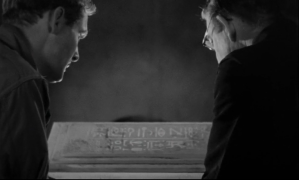
“Death… eternal punishment… for anyone who opens this casket. In the name of Amon-Ra… the king of the Gods”
Lovecraftian terror underpins some of the album’s lyrical thematology and visuality. “Stranger aeons” deserves special mention in this context. It is a song which for many years I did not consider on par with the rest of the songs on this album; it is slow, not as complex as the other songs, and it had that riff that whenever I would hear it I would think of “Ruptured in purulence” by Carcass. Over the years, and by building cultural competences in the field of horror literature, I learned how to love it. The intentional Lovecraftian references include the title, as well as the lyric “lurking at the threshold, you’re lost between the gates”. The latter refers to the book The lurker at the threshold written by August Derleth, based on H. P. Lovecraft‘s universe and some of his unfinished work. Interestingly, and this is where a person’s idiosyncrasy kicks in to continue the cultural production, much of the imagery that’s invoked while listening to this song was not intentionally encoded in the lyrics but inadvertently found its way in. For example, discursive fragments by stories like ‘The thing on the doorstep’ or ‘The lurking fear’ also come to mind when I listen to this song. I literally think of Edward’s liquefied body at the threshold of the house as described in the former, an image that produces a horrifying sentiment, which I don’t think was the intention of Kenny Hakansson when he wrote the lyrics. In such occasions I become a cultural poacher, combining disparate texts in unintended ways to experience unique pleasures.
“Through the collonades” (a misspell of the word colonnades) is the closing song of this extremely thickly textured and complex album, a breathtaking song that has been transformed for me over the years. Although musically it always fascinated me, the cultural input that encouraged me to engage with the lyrics was Lovecraft. When I first listened to Clandestine in the mid-1990s I had not read Lovecraft yet. Only ex-post I can tell that reading those lyrics back in the day did not invoke a visual narrative in my mind, besides the image of walking down a dark path flanked by tall colonnades. It was reading Lovecraft, and especially tales like “The crawling chaos” (co-written by Winifred V. Jackson), that eventually allowed me to produce a coherent tale and a visual landscape in my mind. I love how the mood shifts from sombre to urgent and panicky as the narrator begins to describe the horrors s/he encountered (at 3:08 – “hellish terror risen in the mountains of unknown”). Finally, the horror of waking up from a nightmare only to discover you live in another one is a very Lovecraftian one, and the lyric line “although my dreams have ended, as I wished in weakened thought, beyond the night is total and through the collonades I walk” sends chills down my spine. It also brings into mind the Lovecraftian John Carpenter film In the mouth of madness (1994), where the boundaries between nightmare and reality blur, and the terror of waking up to a nightmarish reality is ever-present.
The above are merely a few of the things that explain my fascination with this album. What this account does not include is the memories from countless hours of listening to it, alone and with friends, for the past 24 years, and of course the pleasure of engaging with this album, both in terms of seeking to learn new things about it, and in terms of surrendering to its magic and allowing it to carry me away into its strange universe.
The entire Clandestine live in 2016
Some of the scholarly ideas that underpin the above narrative can be found in the following:
Bourdieu, P. (1984), Distinction: A social critique of the judgement of taste. London: Routledge.
Jenkins, H. (1992), Textual poachers: Television fans and participatory culture. London: Routledge.
Filed under: death metal, internet and music, popular music, punk | Tags: Bad Religion, city slang, click your fingers uploading the play, Human waste, If you have ghosts, lost, News from the front, Nomeansno, paradise lost, Roky Erickson, Shrines, Sputnik, suffocation, the hellacopters
This is a follow-up to a post I wrote about three years ago, a post I really enjoyed thinking about and writing. This post too is concerned with the idea of the music album as a complete body of works, how the illusion and the sense of conceptual integrity and unity of the album are threatened by ‘bonus tracks’, and how the digitisation/internetisation of music might be implicated in redefining what we mean by a ‘complete’ body of works. Just like in the previous post I will present some examples of awesome songs missing from the standard versions of albums. In all these cases the missing songs are better than most other songs on these albums, effectively calling into question the conceptual integrity of the album, and leaving me with a sense of the album being incomplete. Without further ado here are the songs in question in chronological order:
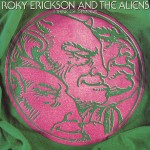 1. Roky Erickson and the Aliens – Click your fingers applauding the play, Sputnik, & If you have ghosts (I think of demons, 1980)
1. Roky Erickson and the Aliens – Click your fingers applauding the play, Sputnik, & If you have ghosts (I think of demons, 1980)
Anything I say about this album is inadequate to express how much I love it. I got introduced to Roky in the late 1990s by Entombed, through their cover of “Night of the vampire”. I originally heard the 1987 re-issue titled The evil one, which contains 15 songs. I bought the 1987 UK vinyl version of this record in 2007, titled I think of demons, and from it the three songs mentioned above were missing. I cannot begin to describe how annoyed I was. A few years later a friend of mine (thanks Aristea) bought me the unabridged The evil one version of the album (which also has the alternate US cover) from the Amoeba record store in California, so now I have those awesome songs as well. It is worth noting that the original version of the album that came out in 1980 has even fewer songs on it than the 1987 UK re-issue. This is another example of the arbitrary nature of albums and what constitutes a complete work of art. Someone could argue that the original album is the complete one, yet the additional songs are clearly recorded in the same period, have the same sound, and are on par with, if not better than, the 10 original cuts.
 2. Suffocation – Human waste (Human waste, 1991)
2. Suffocation – Human waste (Human waste, 1991)
“Human waste” is a track that is missing from the vinyl version of Suffocation’s Human waste EP. As opposed to other songs on this list “Human waste” has different production values than the rest of the songs on this EP, as the sound has clearly ‘demo’ sound quality. In that sense it constitutes more legitimately a ‘bonus’ song which does not threaten the conceptual integrity of the album. At the same time it is both an awesome song and it is the title track! I first listened to the album from a friend’s cassette tape which included the bonus song, and I distinctly remember that “Human waste” and “Catatonia” were the two songs that absolutely blew my mind. I bought the vinyl version from a local record store in my hometown called Paranoid around 1997, and I remember my disappointment when I saw that “Human waste” was missing, and to this day this album feels incomplete.
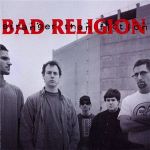 3. Bad Religion – News from the front (Stranger than fiction, 1994)
3. Bad Religion – News from the front (Stranger than fiction, 1994)
The fact that “News from the front” is missing from the standard vinyl version of Stranger than fiction pisses me off immensely, because it is such a superb song with an amazing tempo, extremely catchy chorus, and memorable singing patterns overall. Most importantly, it is hands down better than any of the other songs on the album. I consider Stranger than fiction a weak album, and “News from the front” would motivate me to listen more often to some of the songs I actually like on that album (“Marked”, “Stranger than fiction”, “Better off dead”). Instead, I listen to “News from the front” as part of a compilation b-sides album have on mp3. Over the years, Bad Religion have repeated this crime with the brilliant “The fast life” missing from the standard version of the mediocre (in my opinion) The new America (2000), and the bonus track and B-side masterpieces, “Shattered faith” & “Who we are” respectively, missing from the standard version of The process of belief (2002).
 4. Nomeansno – Lost (The worldhood of the world, 1995)
4. Nomeansno – Lost (The worldhood of the world, 1995)
The album that introduced me to Nomeansno was The worldhood of the world (1995), a CD I bought around 2003 from Sonic Boom, a record store in Kypseli, Athens. I got to listen to the CD before I bought it, and listening to a few songs both enchanted me and confused me. In my head, I was trying my best, to no avail, to unambiguously classify this band. The fact that it did not fit clearly in the punk genre annoyed me (I was relatively new to the punk genre at the time), but, at the same time, I could not stop listening. Anyway, that was the start of a long-term obsession with this brilliant band, which I ended up seeing twice when they played in Brighton, UK, in 2007 and 2013. The song “Lost” is one of the punkiest and most awesome tracks on this album, and is composed by Andy Kerr, who had left the band a few years before this album was released. A few years later I bought the vinyl version of the album and I gave the CD to a friend of mine. Sadly, “Lost” is missing from the vinyl version, which is very annoying. Don’t get me started on the state of Why do they call me Mr. Happy? (1993) on vinyl…
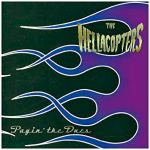 5. The Hellacopters – City slang (Payin’ the dues, 1997)
5. The Hellacopters – City slang (Payin’ the dues, 1997)
“City slang” is a breathtaking song originally by Sonic’s Rendezvous Band. The Hellacopters have played many covers over the years and this one is one of my three favourite ones (the other two are Dead Moon’s “Rescue” and Love’s “A house is not a motel“). It can only be found in the rare vinyl version of Payin’ the dues (1997). Until very recently I did not own that vinyl, so I only had the song on a shitty cassette-tape I made from a friend’s album. In line with what the Hellacopters do, this is a very clean and technically proficient version of the original tune, without, however, lacking in passion and power. Compare Dregen’s carefully reconstructed solo between 2:35-3:00, to the more messy original by Fred Smith. Another excellent call was making the harmony at the end of the song more prominent. The way some of the notes are accentuated during that last bit of the song is also excellent.
 6. Paradise Lost – Shrines (Medusa, 2017)
6. Paradise Lost – Shrines (Medusa, 2017)
“Shrines” is a relatively conventional song, short in duration, with great vocals, a perfect chorus, and a great post-chorus melody. I still cannot believe this masterpiece is missing from the standard version of Medusa! Every time I listen to it I’m pissed off. Over the years, some of Paradise Lost’s most breathtaking tracks have been reserved for singles and EPs (songs like “As I die”, “The rape of virtue“, “Sweetness”, “Fear“, “Master of misrule” spring to mind). “Shrines” is included in the limited digipack edition, and it is a pity, because, in my opinion, is better than most songs on the album (and upon reading the YouTube comments I can see that others have the same opinion). Thankfully, I managed to find and download a copy of the digipack edition, so the album I have on my mp3 feels more complete than the actual vinyl record.
Filed under: death metal, internet and music, people, Underrated masterpieces | Tags: Devastation, Dispensible bloodshed, Duane Rasmussen, Erv Brautigam, Frank Ciampi, Pat Buckley, Troy Dixler
Every once in a while I realise that some album I love is not widely held in high regard. Most of the time I attribute this to subjective taste, but there are some albums which are so absolutely mind-blowing that I cannot get used to the idea that they have not achieved cult status. If there is one album in the history of extreme music that did not receive the recognition it deserves, that album is Devastation‘s Dispensible bloodshed (1987); an absolute masterpiece which never received proper release, except as part of collections of all of Devastation’s songs. It is worth noting that nobody has provided reviews for any of the extremely important releases by Devastation on Encyclopaedia Metallum, and on Mudrian’s comprehensive popular account of death metal Choosing death (2004) there’s hardly a mention to the album or Devastation generally (maybe this has been rectified in the more recent re-issue?).
The Devastation I am talking about in this post is not the more popular Devastation from Texas, but the much, much, much superior Devastation from Chicago. Chicago is often considered one of the birthplaces of death metal, on account of bands like Master and Deathstrike. I have been a passionate fan of death metal music since the mid-1990s and I only got the chance to hear Devastation for the first time around 2008 when I found their MySpace page. Although Devastation never received mainstream recognition, it is a band from the US underground that used to be highly praised in underground death metal in the late 1980s, and has influenced foundational death metal bands around the world. I believe I have read Entombed‘s L. G. Petrov praising Troy Dixler (Devastation’s original singer) in a couple of occasions over the years, and naming him one of his vocal influences. Indeed, Dixler’s brutal performance in Devastation’s first demo, titled A creation of ripping death (1986), is terrifyingly devastating.
Dispensible bloodshed includes seven songs, clocking in at 26 minutes. Two out of seven songs are instrumental; the first one simply titled “Instrumental” is a brutal journey not unlike Sepultura‘s “Inquisition symphony”, in the sense that it starts with an acoustic intro and develops into a whirlwind of unrestrained brutality. The singer on this album is Duane Rasmussen, and his vocal performance is breathtaking. He might not be Troy Dixler, as Duane’s voice is more high-pitched, but he offers an astonishing aggressive performance that does justice to Dixler’s huge legacy. But no words can do justice to the songwriting on this album, as it is truly of the highest order of extreme metal. Listening to this album is not simply about experiencing a rare piece of extreme metal history; it is also about becoming aware of a significant force in the development of the death metal genre. Is there any doubt that the snare-led beating during the fifth and sixth verses of “Genetic poisoning” (and later on as well) had something to do with Cannibal Corpse‘s now classic sound? What about the intro riff and drumming of “Beyond fear“, as well as the more general riffing madness and tempo changes throughout the album? Did they not have an impact on Suffocation‘s genre-defining sound? And I would not be surprised if the second riff of the opening song “Cranial hemorrage” inspired Deicide‘s “Oblivious to evil”. Each song is a journey of absolute awesomeness, and Erv Brautigam (guitar) and Pat Buckley (drums) give the performance of a lifetime.
Dispensible bloodshed was self-released on cassette-tape. How did this masterpiece, which in my opinion was miles ahead of any other death or thrash metal band at the time, slip through the cracks? The very few accounts about the Chicago extreme metal scene I have come across seem to suggest that when Dixler was part of Sindrome he did not want the band to sign with a small independent company (read here), which might have been his attitude during his time with Devastation as well. However, by the time Dispensible bloodshed was released Dixler was out of the band. Shawn Glass (who co-founded Sindrome with Dixler) attributes the disappearance of Devastation and other extreme metal bands from Chicago to inflated egos (read here). In any case, despite the low production values this album has aged extremely well and is an undisputed cornerstone of the death metal genre that needs to be heard.
*Band photo taken from Devastation’s MySpace page
Filed under: brutal memoirs, death metal, internet and music, people, sweden | Tags: But life goes on, Carnage, Deranged from blood, Entombed, Fred Estby, Left hand Path, Matti Karki, Nicke Andersson, Thanks lists
Reading the information provided in the booklets or inner sleeves of albums – on vinyl, CD or cassette-tape – has always been an important part of my – and many others’ I presume – experience of engaging with popular music. Thanks lists used to be the source of finding out about affiliated bands, friendships between bands, and bands that I should check out. At the same time reading bands’ thanks lists would often obscure, rather than clarify, things. Responsible for that would often be the use of inside jokes, such as nicknames and references to events with which I, the reader, was unfamiliar. For example, I remember reading the thanks lists of Napalm Death‘s Harmony corruption (1990) being simultaneously entertained, intrigued and confused by the constant use of the word ‘chuffed’.
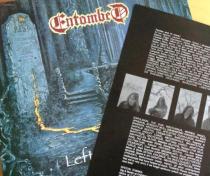 One of the oldest band-related mysteries that I can remember of originated in the inner sleeve of Entombed‘s Left hand path (1990). In the thanks list the band thanks Carnage and then, in brackets, Fred (presumably Fred Estby) who was the drummer in Carnage and Dismember. The sentence “Milli Vannili-Fred! Thanks for the riff mate!” fascinated me because it provided information regarding the relationship between two of my favourite bands – Entombed and Dismember – and also because it provided ammunition to my imaginary debates with annoying staff of heavy metal magazines, among whom it was commonplace to casually refer to Dismember as a “second-rate Entombed”. Yet, this was a piece of information that begged for additional information. For more than 20 years I have wondered, “which one is the riff on Left hand path that belongs to Fred?”.
One of the oldest band-related mysteries that I can remember of originated in the inner sleeve of Entombed‘s Left hand path (1990). In the thanks list the band thanks Carnage and then, in brackets, Fred (presumably Fred Estby) who was the drummer in Carnage and Dismember. The sentence “Milli Vannili-Fred! Thanks for the riff mate!” fascinated me because it provided information regarding the relationship between two of my favourite bands – Entombed and Dismember – and also because it provided ammunition to my imaginary debates with annoying staff of heavy metal magazines, among whom it was commonplace to casually refer to Dismember as a “second-rate Entombed”. Yet, this was a piece of information that begged for additional information. For more than 20 years I have wondered, “which one is the riff on Left hand path that belongs to Fred?”.
Ten years ago I bought and devoured Daniel Ekeroth‘s book Swedish death metal (2008). There were things about it that I loved, and things that I hated. (Among the latter was the author’s irritating flattery towards Nicke Andersson.) One of the things that annoyed me – at the time I thought it was unacceptable – was that he did not provide an answer to this mystery. Even though I understand that it is not really a mystery, in the sense that probably nobody cares, I still think that revealing the identity of the riff would be a great anecdote which would also provide a richer, more accurate representation of the relationship between these two important bands and songwriters of the Swedish death metal scene.
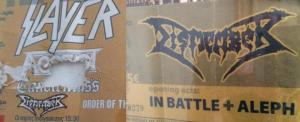
Dismember appearing at the Rockwave festival in Attica, 2005 (left), and Mylos club in Thessaloniki, 2007 (right).
Twice I had the opportunity to find out the answer to this mystery but missed it. I have seen Dismember live twice. The first time was in the 2005 Rockwave festival in Greece. There I actually met Fred, David, and Matti who were wandering around in the merchandising area, but it was very brief and I completely forgot to ask Fred about the Left had path reference. (During that brief encounter Fred recorded my Dismember tattoo on his camera, and the footage was later on included in their Under blood red skies DVD (2009)!) Next time I saw Dismember live was in Thessaloniki a couple of years later, and it was shortly after Fred’s departure from the band (Thomas was on drums by that point), so, once again, I missed the chance to inquire. What I never considered was that perhaps someone else from the band might know the answer to my question. As it turns out Matti did, and last week this minor mystery was solved while I was browsing Matti’s Facebook page.
I have referred to social media as “intertextual enablers” in the past (read this), and this is another instance where information produced and accessed through social media fills in gaps in my popular music knowledge. Later on in the same Facebook discussion, it is revealed that the riff mentioned above which Nicke gave in return was the brilliant intro riff of “Deranged from blood” from Carnage’s Dark recollections (1990). Of course, the “Milli Vannili-Fred” bit of the reference has not been explained. It obviously refers to the late-1980s Dance duo Milli Vanilli, which consisted of two models posing as singers (without actually singing or composing on the records). Perhaps in the context of Left hand path, the term is meant to refer jokingly to Fred as a ghost writer in Entombed. Now enjoy Fred’s riff starting at 1:32 in the video below.
Filed under: internet and music, metal, people, popular music | Tags: Andre Tolhuisen, anniversary, Carcass, Jeff Walker, overground scene, Ron van de Polder
I started this blog 10 years ago, on July 4, 2008, during a challenging period of my life, in pursuit of some meaningful interaction around popular music. This clearly did not happen, but I decided against using this anniversary post to discuss the communicative opportunities and limitations of the internet, or the practice of debating (or the written word for that matter!) as an obsolete mode of social interaction. Instead, I’ll recount some of best moments associated with producing Overground Scene over the last 10 years.
Firstly, the practice of blogging, the translation from the more ephemeral (i.e. passing thoughts) to the more permanent so to speak (i.e. blog-posts), has been a pleasure in itself. I presume this translation must be one of the most attractive aspects of social media generally. Writing a post is much more than simply transferring one’s thoughts to written form on a web-page. Undergoing this translation, for me, means mobilising skills accumulated over many years of writing, reading music magazines, and absorbing various cultures of media production. There is effort involved in creating posts that are intelligible (an epithet that does not really apply to most of the early posts on this blog), both in terms of syntax, and curating (e.g. the inclusion of peripheral aspects of an argument – mainly images). Mobilising all these skills and seeing the end result of this labour has always been very fulfilling.
The fact that some people enjoyed my blog and registered to receive updates means a lot to me and constitutes an encouraging reminder that I am not simply talking to myself. But through this blog I also got the unexpected opportunity to interact with some of the people I have admired since my childhood. Jeff Walker, the singer/songwriter of Carcass, one of the most excellent bands in the world and a band I respect and love, came across my review of Carcass’s comeback album and, I presume, regarded it a healthy expression of fandom. He then posted the following update on the band’s Facebook profile, by which I am massively honoured and at the same time constitutes an incredible act of legitimation.
Another highlight was the brief interaction with Andre Tolhuisen and Ron van de Polder from Sinister, two musicians that I have also admired since the mid-1990s. Andre contacted me through the comments section of a post I wrote about Ron and his significant contribution to extreme metal. This initial contact led to an interview with Andre, whose brief contribution through Sinister’s sophomore album is also hugely significant. This interview led to one of my favourite posts celebrating the 20th anniversary of Diabolical Summoning (1993). Ron also came across the post dedicated to him and commented briefly. I understand that most people would not wait until their favourite musicians accidentally came across their blog to interact with them. Most people would simply add those people on Facebook or follow them on Twitter, but myself, being a bit more old-fashioned and quite unable to embrace the social media “revolution”, would never do something of the sort (I would consider it overstepping boundaries). So, the fact that these people contacted me or cited my blog means a lot to me.
By this point, I have established several themes that I enjoy writing and have contributed several installments, including famous break-ups (What happened to us?), obscure references among bands or between bands and other popular culture texts (Is this where I came from?), important musicians that are inactive (Whatever happened to …?), and unfavourably reviewed albums (On reviewing). Some of my posts, for reasons I cannot know, have been much more popular than most. The post about the influence of H. P. Lovecraft on death metal has been one of the most read and commented on (and plagiarised by other blogs/websites). If anything resembled the kind of interaction I hoped to achieve through this blog, that would be the comments section of this post. Another post that still brings in traffic daily is the one on my favourite Swedish death metal albums (everyone likes a list). The post on Carcass’s comeback album (This Carcass feel) is also quite popular, mainly due to people still searching for the meaning of the number appearing during the chorus of “The granulating satanic mills” (I believe that a reader of this blog – Bill’s left pinky – offered the most plausible interpretation in one of the comments on the respective post – October 9, 2013).
On the occasion of this post I would like to articulate anew my commitment to writing about popular music from a critical perspective, and denying to provide a platform to any fascist discourses and their producers. Loving metal (or any other kind of music) does not mean that we should accept our favourite musicians and the fruits of their labour unconditionally. Music fans and musicians who believe in compassion and equality should be vocal about it, especially since ‘being vocal’ seems to be the default position of people who lack compassion and hate the idea of equality. Of course, there are also bands and music fans that are unapologetic enemies of humanity, compassion, and equality. These people are usually threatened by women who speak against rape, by victims of our racist colonial legacy who speak against racism, people who question oppressive gender and sexuality norms, and so forth. Sometimes, the reason why some feel threatened by such fights for justice is because they feel that they are better off with the status quo, not even considering the possibility that treating people better would also make their own lives better, more worth living. More often, though, these people are simply pawns in the games of much more powerful social actors and institutions, the Trumps, Farages, and Breitbarts of this world. Some of us still operate within political and judicial contexts where the extermination of dissenting voices is not yet common practice, but it is also terrifying to think that some others live in “democracies” where speaking out against orthodoxy equals at best imprisonment, at worst death. As such, speaking out is a precarious privilege and we should be making use of it, fostering it, improving it. I will end this post with a playlist that spans the years that this blog has been active. Enjoy responsibly.
*Images used to create this collage taken from:
Filed under: death metal, internet and music, On reviewing, people | Tags: At the Gates, Atheist, elitism, encyclopaedia metallum, jupiter, Kataklysm, Slaughter of the soul, temple of knowledge
This is the second installment (read the first installment here) in the series of posts that I write to let off steam and make fun of Encyclopaedia Metallum reviewers. I like to think that all different kinds of music have the potential to give pleasure to people, and that whether one enjoys a certain band/artist or not depends on their personal tastes and their desire and capacity to invest time understanding said band/artist. In this blog, I avoid talking about bands I haven’t invested time listening to or trying to understand, or bands that I haven’t found something nice to say about. Even when I acknowledge that a band or an album disappointed me, I make it very clear that it is a subjective opinion rather than a “fact”. One of the things I hate is when album reviewers talk about albums as if they express an “objective fact” or feel that their opinions are representative of audiences’ opinions.
Before I continue, I would like to explain that the reason why I choose to ridicule reviews written by “common fans”, as opposed to more “professional” critics that write for publications such as Metal Hammer, Metal Sucks, All Music, and so on, is not because I think that the latter do not deserve ridicule. If anything all those publications have set the standard in terrible reviewing. And most certainly I do not want to insinuate that because someone’s review has the seal of approval of an official publication it automatically has value. The reason I focus on the reviews of Encyclopaedia Metallum users is simply because I no longer read, and for a long time have not been reading, the reviews of any of the aforementioned publications.
In this post, as opposed to my previous post on reviewing albums, I will not talk about albums that have an overall terrible rating, but rather infuriatingly ridiculous reviews I accidentally came across about albums I consider brilliant. As I demonstrate in the three reviews that follow, through my brief “research” on Encyclopaedia Metallum‘s reviews section, I identify two types of annoying reviewers: the dunderhead, and the elitist prick. Of course, one could always assume that some reviewers are simply trolls, in which case they do their job pretty well!
 1. Kataklysm – Temple of knowledge (72% on Encyclopaedia Metallum)
1. Kataklysm – Temple of knowledge (72% on Encyclopaedia Metallum)
This album is a masterpiece, and my favourite death metal album to have ever come out of Canada. Listening to it makes my skin crawl. Although strictly in a musical sense this album is by no means revolutionary, the execution, lyrical themes, and vocals make it an extraordinary death metal artifact. The intensity and absurdity of the pace of the music and vocal performance elevates this album to a league of its own. The music, although overall simplistic, is quite impressive, most musical sentences are extremely inventive (e.g. beginning of “Fathers from the suns”), and the way the band keeps pushing itself to new extremes is unprecedented. Now, on Encyclopaedia Metallum one person gave it a 10% and another 42%. These two reviews are very much representative of the kinds of people who tend to give bad reviews: one, the complete dunderhead with surprising self-confidence, and, two, the elitist prick who makes us feel thankful (or, at least, hopeful) that his/her influence is limited to Encyclopaedia Metallum and not in more significant social fields (education, government, mass media). In this case the dunderhead gave it a 10%, but commenting on that would be taking a cheap shot. So, I move on to the elitist prick who gave it a 42%. His review is laden with the usual elitist tantrums about pseudo-individualisation that would make Theodor Adorno blush, and “profound” insights on the thought processes of audiences (who apparently listen to music in the exact same way as he does). It is indeed ironic how this person, who clearly holds himself and his tastes in extremely high regard, at the same time without a shadow of a doubt proves himself completely ignorant by assuming that everyone engages with culture in a uniform way. He should do the world a favour and hurl himself off the top of the temple of knowledge on which he thinks he is sitting. My rating: 97%
 2. At The Gates – Slaughter of the soul (71% on Encyclopaedia Metallum)
2. At The Gates – Slaughter of the soul (71% on Encyclopaedia Metallum)
In the case of ATG’s most popular album we can see the usual suspects spewing diarrhea in written form. Six out of 25 reviews give the album a bad rating. I will not dwell on all of them, instead I will focus on the one reviewer who gave it a 0% and clearly has never experienced joy in his life. I pity the fool. I would go out on a limb and argue that this person is either an arts student or cultural studies student who has done a very basic and uncritical reading of the Frankfurt School’s critiques of mass culture, or some poor soul who has made the phrase “you are what you consume” his modus operandi, and thinks that by consuming culture that is socially legitimated as high he will automatically occupy a much-desired high position in society. Once again we have a review of utter elitist drivel about what is high and what is low art, full of token aphorisms of mass-produced culture, McDonaldisation, and so forth. Maybe by the end of his degree he changed his mind, although if this review is representative of his student work then there’s not much promise for the future. His comment on LaRocque’s astonishing solo on “Cold” is pure blasphemy. If he listened to SOTS, an album that is the result of unbelievable effort and talent, the embodiment of years of experience, and which has had an enduring impact on popular music, and the only thing he had to say is that it is worth nothing, then the only thing I have to say about him is the above. My rating: 100%
 3. Atheist – Jupiter (72% on Encyclopaedia Metallum)
3. Atheist – Jupiter (72% on Encyclopaedia Metallum)
Atheist’s Jupiter was my favourite album of 2010, alongside Imperial State Electric’s, Desultory’s and Blind Guardian’s albums of that year. Again here I will focus on the prodigy who gave this album a 0%. The person who wrote the review in question informs his readers from the outset that Atheist is “one of [his] first death metal bands”, in a pathetic attempt to invest his opinion with credibility. I wouldn’t be surprised if he started listening to death metal a month before he typed this review, and, truthful to his claim, at the beginning of that month he listened to Atheist. He goes on and on about how terrible the production is and how this is the major flaw of this album; jeeesus faux-king christ, some albums happen to be badly produced, or one might dislike the production; it happens all the time, get over it and listen to the faux-king album. What about Piece of time (1989) where the kick-drum almost completely drowns out the snare drum in all the fast songs?! After that he gets obsessed with the technicality of the album. I don’t believe I have read “tech” so many times in my life in one piece of writing. Of course, every single word he writes is completely subjective. He simply does not like the album, end of story. Along the way he references a bunch of contemporary bands (The faceless, Suicide silence, Mudvayne) which he implies are shit, but at the same time possesses suspicious reserves of knowledge about them as he compares specific bits of Jupiter to those bands. It’s almost as if he listens to those shitty bands. Almost as if he likes them. Interesting… Anyway, through his review he also plugs a website he is writing for, although this review is hardly an advertisement. This album is brilliant and from the day it came out ’till this very day I worship it (as much as I worship the first and second Atheist albums). If I have one problem with this album is that it is so brilliant that when it ends I’m sad. My rating: 96%


